Optimal Agronomics Increase Grain Yield and Grain Yield Stability of Ultra-Early Wheat Seeding Systems
Abstract
1. Introduction
2. Materials and Methods
2.1. Site Description, Experimental Design, and Determination of Planting Time Using Soil Temperature Triggers
2.2. Seeding Operations, Nutrient Management, and Pest Management
2.3. Data Collection
2.4. Statistical Analyses
3. Results
3.1. Environmental Conditions
3.2. Grain Yield, Grain Quality and Yield Components
3.3. Crop Development
3.4. Grain Yield Stability
4. Discussion
4.1. Soil Temperature Based Planting
4.2. Grain Yield Response to Ultra-Early Wheat Seeding Systems
4.3. Agronomic Management of Ultra-Early Wheat Seeding Systems
4.4. Producer Level Implementation
5. Conclusions
Author Contributions
Funding
Institutional Review Board Statement
Informed Consent Statement
Data Availability Statement
Acknowledgments
Conflicts of Interest
Abbreviations
References
- FAOSTAT. Food and Agricultural Organization Statistical Databases; FAO: Rome, Italy, 2020; Available online: http://www.fao.org/faostat/en/#data (accessed on 2 May 2020).
- Statistics Canada 2020. Table 32-10-0359-01 Estimated areas, yield, production, average farm price and total farm value of principal field crops, in metric and imperial units. Available online: https://www150.statcan.gc.ca/t1/tbl1/en/tv.action?pid=3210035901 (accessed on 2 May 2020).
- Beres, B.L.; Hatfield, J.L.; Kirkegaard, J.A.; Eigenbrode, S.D.; Pan, W.L.; Lollato, R.P.; Hunt, J.R.; Strydhorst, S.; Porker, K.; Lyon, D.; et al. Toward a better understanding of genotype × environment × management interactions—A global wheat initiative agronomic research strategy. Front. Plant Sci. 2020, 11, 828. [Google Scholar] [CrossRef] [PubMed]
- Drury, C.F.; Reynolds, W.; Tan, C.S.; McLaughlin, N.B.; Yang, X.M.; Calder, W.; Oloya, T.O.; Yang, J.Y. Impacts of 49–51 years of fertilization and crop rotation on growing season nitrous oxide emissions, nitrogen uptake and corn yields. Can. J. Soil Sci. 2014, 94, 421–433. [Google Scholar] [CrossRef]
- He, W.; Yang, J.Y.; Qian, B.; Drury, C.F.; Hoogenboom, G.; He, P.; Lapen, D.; Zhou, W. Climate change impacts on crop yield, soil water balance and nitrate leaching in the semiarid and humid regions of Canada. PLoS ONE 2018, 13, e0207370. [Google Scholar] [CrossRef] [PubMed]
- Iqbal, M.; Moakhar, N.P.; Strenzke, K.; Haile, T.; Pozniak, C.; Hucl, P.; Spaner, D. Genetic improvement in grain yield and other traits of wheat grown in western Canada. Crop. Sci. 2016, 56, 613–624. [Google Scholar] [CrossRef]
- Thomas, J.B.; Graf, R. Rates of yield gain of hard red spring wheat in western Canada. Can. J. Plant Sci. 2014, 94, 1–13. [Google Scholar] [CrossRef]
- Collier, G.R.S.; Spaner, D.M.; Graf, R.J.; Beres, B.L. The integration of spring and winter wheat genetics with agronomy for ultra-early planting into cold soils. Front. Plant Sci. 2020, 11, 89. [Google Scholar] [CrossRef]
- Iqbal, M.; Navabi, A.; Salmon, D.F.; Yang, R.-C.; Spaner, D. Simultaneous selection for early maturity, increased grain yield and elevated grain protein content in spring wheat. Plant Breed. 2007, 126, 244–250. [Google Scholar] [CrossRef]
- Lanning, S.P.; Kephart, K.; Carlson, G.R.; Eckhoff, J.E.; Stougaard, R.N.; Wichman, D.M.; Martin, J.M.; Talbert, L.E. Climatic change and agronomic performance of hard red spring wheat from 1950 to 2007. Crop. Sci. 2010, 50, 835–841. [Google Scholar] [CrossRef]
- Cutforth, H.; O’Brien, E.; Tuchelt, J.; Rickwood, R. Long-term changes in the frost-free season on the Canadian prairies. Can. J. Plant Sci. 2004, 84, 1085–1091. [Google Scholar] [CrossRef]
- Asseng, S.; Martre, P.; Maiorano, A.; Rötter, R.P.; O’Leary, G.J.; Fitzgerald, G.; Girousse, C.; Motzo, R.; Giunta, F.; Babar, M.A.; et al. Climate change impact and adaptation for wheat protein. Glob. Chang. Biol. 2019, 25, 155–173. [Google Scholar] [CrossRef]
- Asseng, S.; Jamieson, P.; Kimball, B.; Pinter, P.; Sayre, K.; Bowden, J.; Howden, M. Simulated wheat growth affected by rising temperature, increased water deficit and elevated atmospheric CO2. Field Crop. Res. 2004, 85, 85–102. [Google Scholar] [CrossRef]
- He, Y.; Wang, H.; Qian, B.; McConkey, B.; Depauw, R. How early can the seeding dates of spring wheat be under current and future climate in Saskatchewan, Canada? PLoS ONE 2012, 7, e45153. [Google Scholar] [CrossRef] [PubMed]
- Briggs, K.G.; Ayten-Fisu, A. The effects of seeding rate, seeding date and location on grain yield, maturity, protein percentage and protein yield of some spring wheats in central Alberta. Can. J. Plant Sci. 1979, 59, 1139–1145. [Google Scholar] [CrossRef]
- Lanning, S.P.; Hucl, P.; Pumphrey, M.; Carter, A.H.; Lamb, P.F.; Carlson, G.R.; Wichman, D.M.; Kephart, K.D.; Spaner, D.; Martin, J.M.; et al. Agronomic performance of spring wheat as related to planting date and photoperiod response. Crop. Sci. 2012, 52, 1633–1639. [Google Scholar] [CrossRef]
- Larter, E.N.; Kaltsikes, P.J.; McGinnis, R.C. Effect of date and rate of seeding on the performance of triticale in comparison to wheat 1. Crop. Sci. 1971, 11, 593–595. [Google Scholar] [CrossRef]
- McKenzie, R.H.; Middleton, A.B.; Dunn, R.; Sadasivaiah, R.S.; Beres, B.; Bremer, E. Response of irrigated soft white spring wheat to seeding date, seeding rate and fertilization. Can. J. Plant Sci. 2008, 88, 291–298. [Google Scholar] [CrossRef]
- McKenzie, R.H.; Bremer, E.; Middleton, A.B.; Pfiffner, P.G.; Woods, S.A. Optimum seeding date and rate for irrigated cereal and oilseed crops in southern Alberta. Can. J. Plant Sci. 2011, 91, 293–303. [Google Scholar] [CrossRef]
- Kouadio, A.L.; Newlands, N.; Potgieter, A.; McLean, G.; Hill, H. Exploring the potential impacts of climate variability on spring wheat yield with the APSIM decision support tool. Agric. Sci. 2015, 6, 686–698. [Google Scholar] [CrossRef]
- Qian, B.; Zhang, X.; Smith, W.; Grant, B.; Jing, Q.; Cannon, A.J.; Neilsen, D.; McConkey, B.; Li, G.; Bonsal, B.; et al. Climate change impacts on Canadian yields of spring wheat, canola and maize for global warming levels of 1.5 °C, 2.0 °C, 2.5 °C and 3.0 °C. Environ. Res. Lett. 2019, 14, 074005. [Google Scholar] [CrossRef]
- Hunt, J.R.; Hayman, P.T.; Richards, R.A.; Passioura, J.B. Opportunities to reduce heat damage in rain-fed wheat crops based on plant breeding and agronomic management. Field Crop. Res. 2018, 224, 126–138. [Google Scholar] [CrossRef]
- Kirkegaard, J.; Lilley, J.M.; Hunt, J.R.; Sprague, S.J.; Ytting, N.K.; Rasmussen, I.S.; Graham, J.M. Effect of defoliation by grazing or shoot removal on the root growth of field-grown wheat (Triticum aestivum L.). Crop. Pasture Sci. 2015, 66, 249–259. [Google Scholar] [CrossRef]
- Grant, M.N. Registration of Norstar wheat 1 (Reg. No. 626). Crop. Sci. 1980, 20, 552. [Google Scholar] [CrossRef]
- Larsen, R.J.A. Winter-hardy spring wheat breeding: Analysis of winter x spring wheat germplasm and the development of selection tools. 2012. Available online: http://atrium.lib.uoguelph.ca/xmlui/handle/10214/3975 (accessed on 4 May 2020).
- Shaner, D.L. (Ed.) Herbicide Handbook, 10th ed.; Weed Science Society of America: Lawrence, KS, USA, 2014. [Google Scholar]
- Gower, S.T.; Kucharik, C.J.; Norman, J.M. Direct and indirect estimation of leaf area index, fAPAR, and net primary production of terrestrial ecosystems. Remote Sens. Environ. 1999, 70, 29–51. [Google Scholar] [CrossRef]
- Jonckheere, I.; Fleck, S.; Nackaerts, K.; Muys, B.; Coppin, P.; Weiss, M.; Baret, F. Review of methods for in situ leaf area index determination. Agric. For. Meteorol. 2004, 121, 19–35. [Google Scholar] [CrossRef]
- ACIS 2020. Alberta Climate Information Service. Alberta Agriculture and Forestry. Available online: https://acis.alberta.ca (accessed on 12 November 2020).
- Irvine, R.B.; Lafond, G.P.; May, W.; Kutcher, H.R.; Clayton, G.W.; Harker, K.N.; Turkington, T.K.; Beres, B.L. Stubble options for winter wheat in the black soil zone of western Canada. Can. J. Plant Sci. 2013, 93, 261–270. [Google Scholar] [CrossRef]
- SAS Institute. SAS/STAT 9.2 User’s Guide, 2nd ed.; SAS Institute Inc.: Cary, NC, USA, 2009. [Google Scholar]
- Littell, R.C.; Milliken, G.A.; Stroup, W.W.; Wolfinger, R.D. SAS Systems for Mixed Models, 2nd ed.; SAS Institute Inc.: Cary, NC, USA, 2006; p. 813. [Google Scholar]
- Steel, R.G.D.; Torrie, J.H.; Dickey, D.A. Principles and Procedures of Statistics: A Biometrical Approach; McGraw-Hill: New York, NY, USA, 1997; 666p. [Google Scholar]
- Yang, R.-C.; Juskiw, P. Analysis of covariance in agronomy and crop research. Can. J. Plant Sci. 2011, 91, 621–641. [Google Scholar] [CrossRef]
- Francis, T.R.; Kannenberg, L.W. Yield stability studies in short-season maize. I. A descriptive method for grouping genotypes. Can. J. Plant Sci. 1978, 58, 1029–1034. [Google Scholar] [CrossRef]
- Döring, T.F.; Reckling, M. Detecting global trends of cereal yield stability by adjusting the coefficient of variation. Eur. J. Agron. 2018, 99, 30–36. [Google Scholar] [CrossRef]
- Taylor, L.R. Aggregation, variance and the mean. Nat. Cell Biol. 1961, 189, 732–735. [Google Scholar] [CrossRef]
- Döring, T.F.; Knapp, S.; Cohen, J.E. Taylor’s power law and the stability of crop yields. Field Crop. Res. 2015, 183, 294–302. [Google Scholar] [CrossRef]
- Shen, S.S.P.; Yin, H.; Cannon, K.; Howard, A.; Chetner, S.; Karl, T.R. Temporal and spatial changes of the agroclimate in Alberta, Canada, from 1901 to 2002. J. Appl. Meteorol. 2005, 44, 1090–1105. [Google Scholar] [CrossRef]
- Zhao, L.; Gray, D.M.; Toth, B. Influence of soil texture on snowmelt infiltration into frozen soils. Can. J. Soil Sci. 2002, 82, 75–83. [Google Scholar] [CrossRef]
- Depauw, R.M.; Knox, R.E.; Clarke, F.; Clarke, J.M.; McCaig, T.N. Stettler hard red spring wheat. Can. J. Plant Sci. 2009, 89, 945–951. [Google Scholar] [CrossRef]
- Fowler, D.B. Cold acclimation threshold induction temperatures in cereals. Crop. Sci. 2008, 48, 1147–1154. [Google Scholar] [CrossRef]
- Porker, K.; Straight, M.; Hunt, J.R. Evaluation of G × E × M Interactions to increase harvest index and yield of early sown wheat. Front. Plant Sci. 2020, 11, 994. [Google Scholar] [CrossRef]
- Farooq, M.; Bramley, H.; Palta, J.A.; Siddique, K.H.M. Heat stress in wheat during reproductive and grin-filling phases. Crit. Rev. Plant Sci. 2011, 30, 491–507. [Google Scholar] [CrossRef]
- Cann, D.J.; Schillinger, W.F.; Hunt, J.R.; Porker, K.D.; Harris, F.A.J. Agroecological advantages of early-sown winter wheat in semi-arid environments: A comparative case study from southern Australia and Pacific Northwest United States. Front. Plant Sci. 2020, 11, 568. [Google Scholar] [CrossRef]
- Hunt, J.; Lilley, J.M.; Trevaskis, B.; Flohr, B.M.; Peake, A.; Fletcher, A.; Zwart, A.B.; Gobbett, D.L.; Kirkegaard, J.A. Early sowing systems can boost Australian wheat yields despite recent climate change. Nat. Clim. Chang. 2019, 9, 244–247. [Google Scholar] [CrossRef]
- Alberta Wheat Commission 2020. Alberta Wheat Commission Price and Data Quotes—Price History. Available online: https://www.pdqinfo.ca/history (accessed on 29 December 2020).
- Fischer, R. Definitions and determination of crop yield, yield gaps, and of rates of change. Field Crop. Res. 2015, 182, 9–18. [Google Scholar] [CrossRef]
- Kirkegaard, J.; Hunt, J.R. Increasing productivity by matching farming system management and genotype in water-limited environments. J. Exp. Bot. 2010, 61, 4129–4143. [Google Scholar] [CrossRef]
- Beres, B.L.; Rahmani, E.; Clarke, J.M.; Grassini, P.; Pozniak, C.J.; Geddes, C.M.; Porker, K.D.; May, W.E.; Ransom, J.K. A systematic review of durum wheat: Enhancing production systems by exploring genotype, environment, and management (G × E × M) synergies. Front. Plant Sci. 2020, 11, 568657. [Google Scholar] [CrossRef] [PubMed]
- Cassman, K.G.; Grassini, P. A global perspective on sustainable intensification research. Nat. Sustain. 2020, 3, 262–268. [Google Scholar] [CrossRef]
- Fischer, R.A.; Connor, D. Issues for cropping and agricultural science in the next 20 years. Field Crop. Res. 2018, 222, 121–142. [Google Scholar] [CrossRef]
- Beres, B.L.; Turkington, T.K.; Kutcher, H.R.; Irvine, B.; Johnson, E.N.; O’Donovan, J.T.; Harker, K.N.; Holzapfel, C.B.; Mohr, R.; Peng, G.; et al. Winter wheat cropping system response to seed treatments, seed size, and sowing density. Agron. J. 2016, 108, 1101–1111. [Google Scholar] [CrossRef]
- Ford, K.A.; Casida, J.E.; Chandran, D.; Gulevich, A.G.; Okrent, R.A.; Durkin, K.A.; Sarpong, R.; Bunnelle, E.M.; Wildermuth, M.C. Neonicotinoid insecticides induce salicylate-associated plant defense responses. Proc. Natl. Acad. Sci. USA 2010, 107, 17527–17532. [Google Scholar] [CrossRef]
- Turkington, T.K.; Beres, B.L.; Kutcher, H.R.; Irvine, B.; Johnson, E.N.; O’Donovan, J.T.; Harker, K.N.; Holzapfel, C.B.; Mohr, R.; Peng, G.; et al. Winter wheat yields are increased by seed treatment and fall-applied fungicide. Agron. J. 2016, 108, 1379–1389. [Google Scholar] [CrossRef]
- Pandey, M.; Singh, A.K.; DePauw, R.M.; Bokore, F.E.; Ellouze, W.; Knox, R.E.; Cuthbert, R.D. Coleoptile length, gibberellin sensitivity, and plant height variation of durum wheat in Canada. Can. J. Plant Sci. 2015, 95, 1259–1264. [Google Scholar]
- Ellis, M.H.; Rebetzke, G.J.; Chandler, P.; Bonnett, D.; Spielmeyer, W.; Richards, R. The effect of different height reducing genes on the early growth of wheat. Funct. Plant Biol. 2004, 31, 583–589. [Google Scholar] [CrossRef]
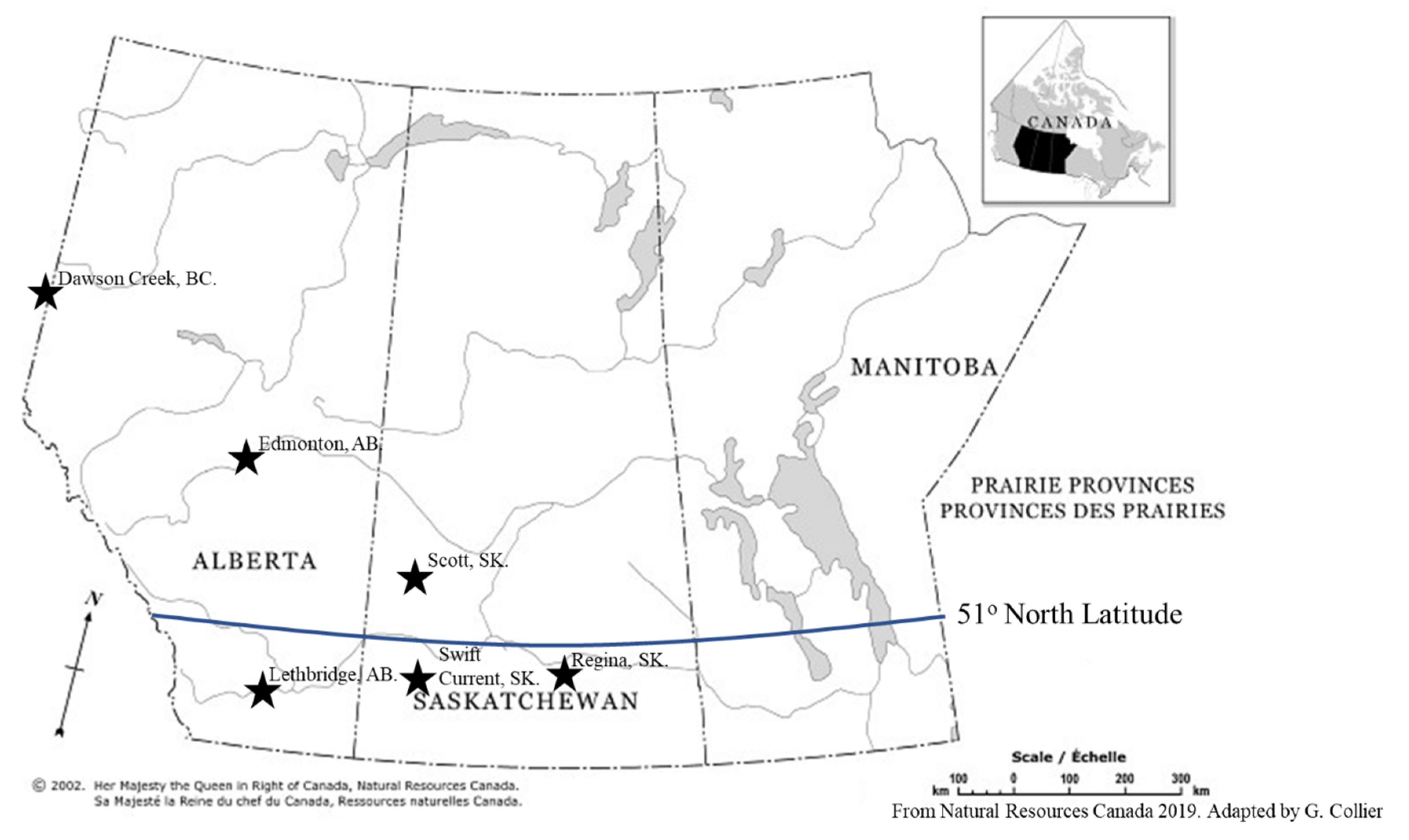
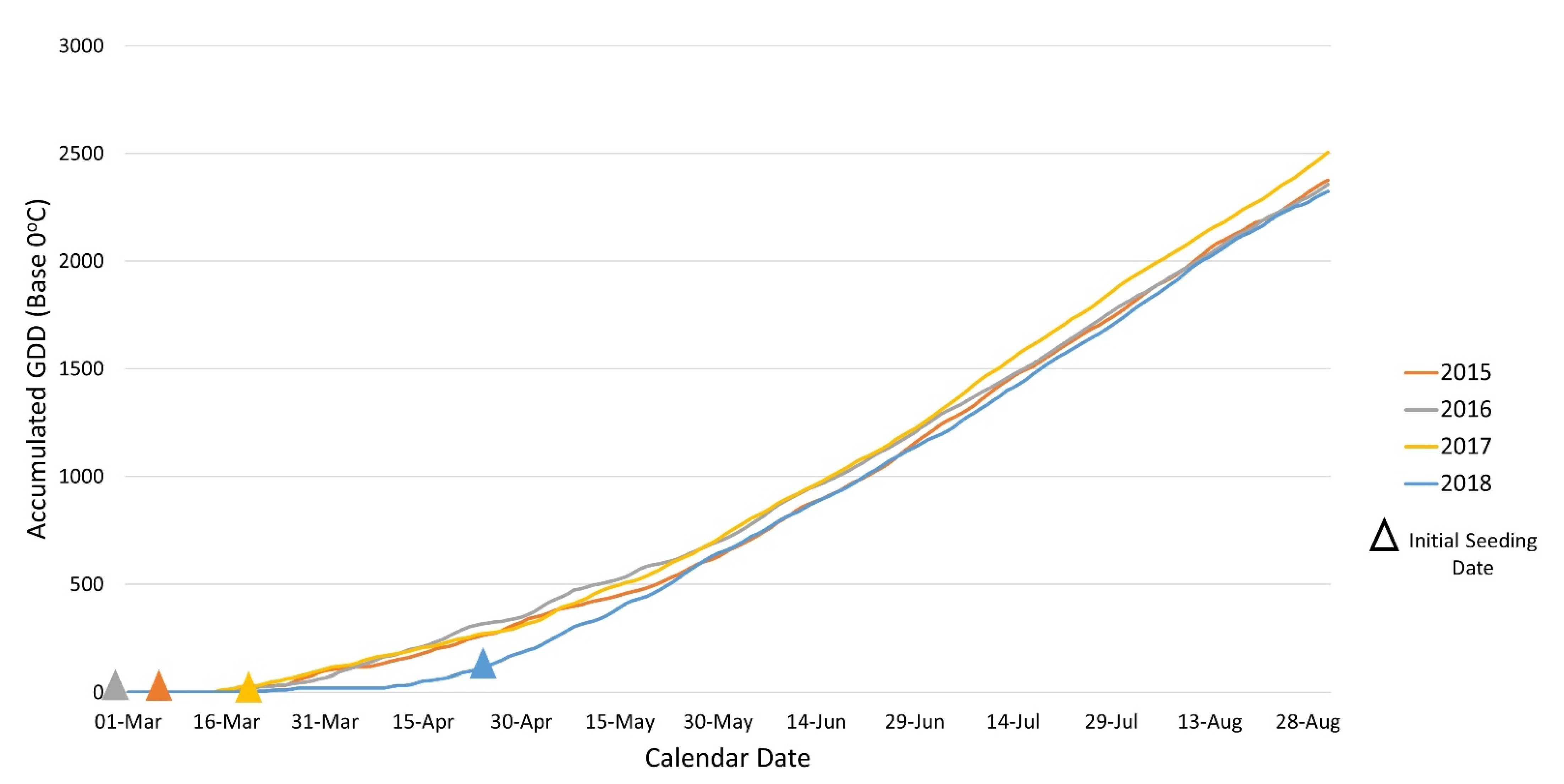
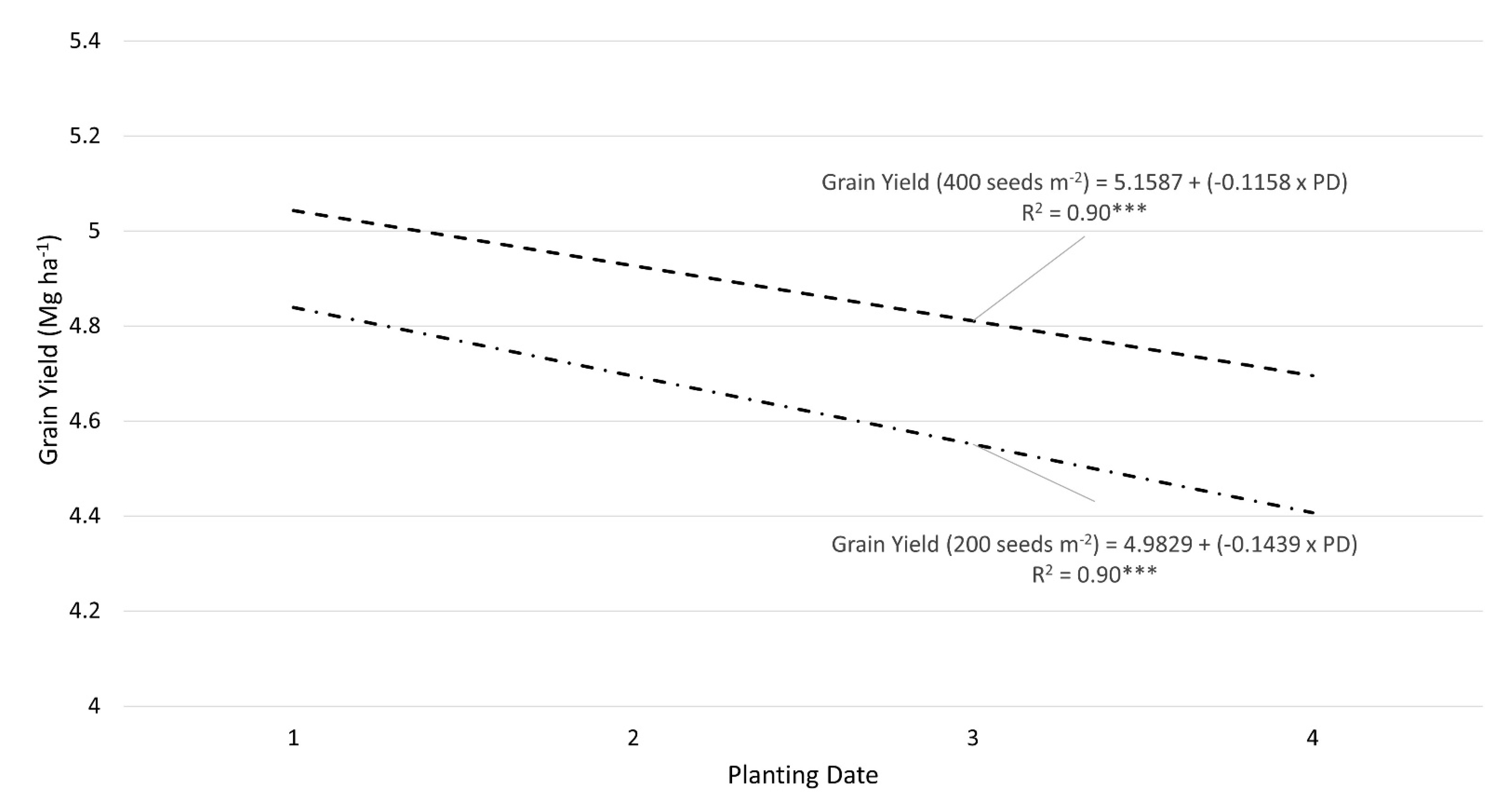
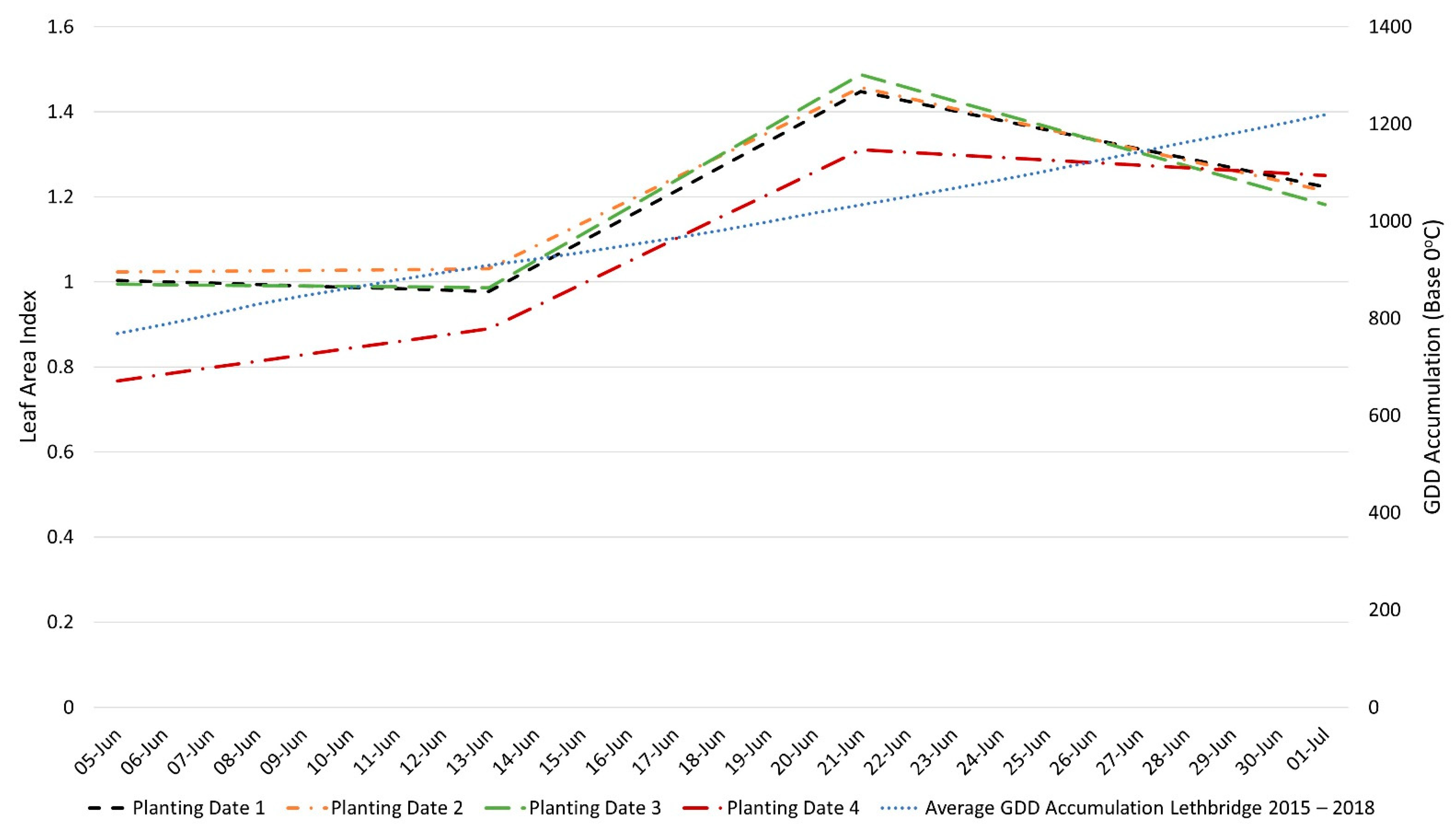
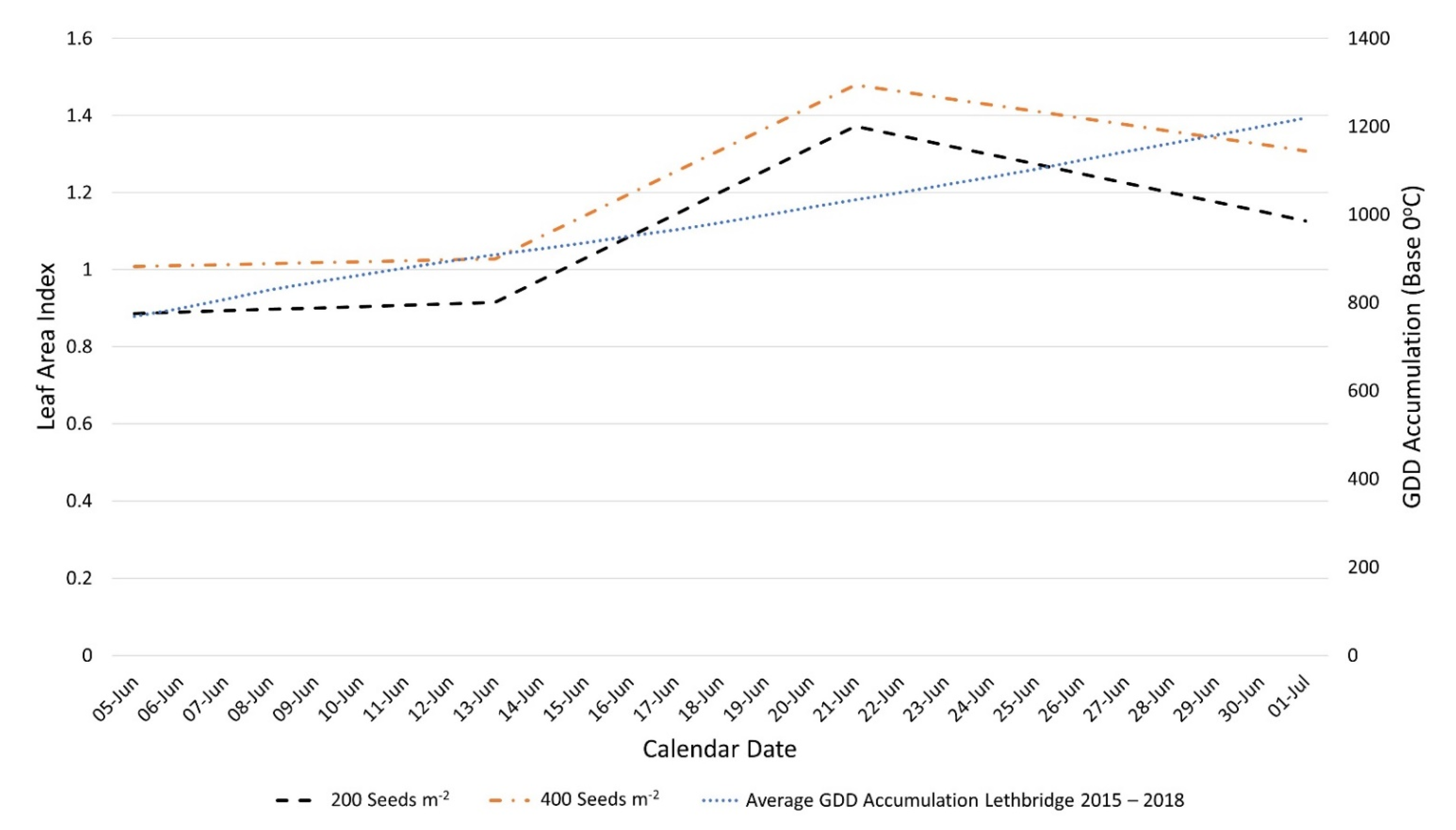
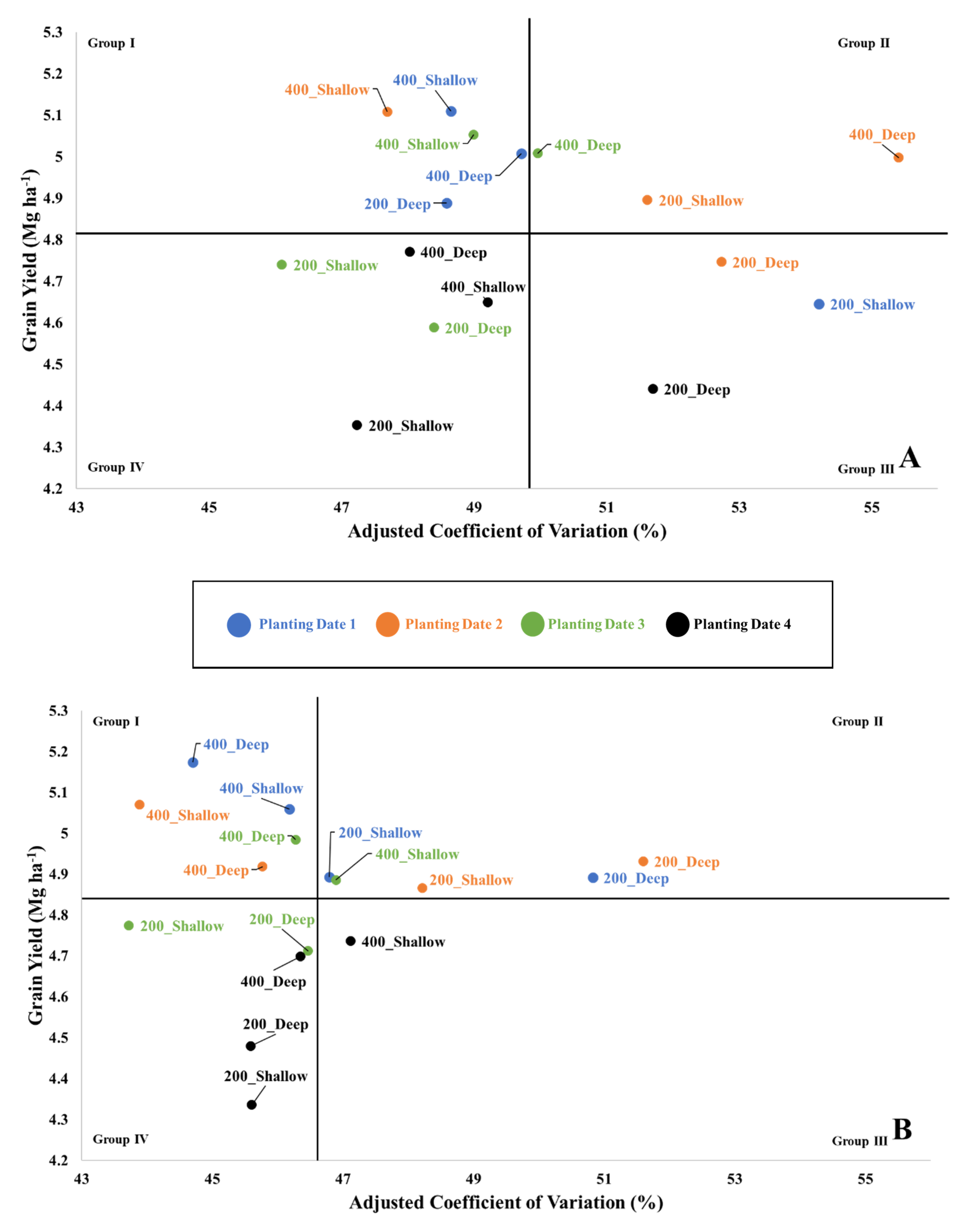
| Location | Latitude/Longitude | Agroecological Region | Soil Zone | Average Yearly Precipitation * (mm) | Year | Actual Precipitation (mm) | Earliest Seeding Date ** | Number of Days with Air Temperature below 0 °C after Initial Seeding Date | Lowest Air Temperature Recorded after Seeding (°C) |
|---|---|---|---|---|---|---|---|---|---|
| Dawson Creek, BC | 55°48′ N 120°14′ W | Parkland | Grey Wooded | 453 | 2015 | 325 | 16 April | 12 | −5.0 |
| 2016 | 542 | 21 April | 11 | −6.1 | |||||
| Edmonton, AB | 53°33′ N 113°29′ W | Parkland | Black | 446 | 2015 | 299 | 9 April | 12 | −4.2 |
| 2016 | 510 | 29 March | 11 | −3.6 | |||||
| 2017 | 416 | 5 May | 0 | 2.3 | |||||
| Lethbridge, AB | 49°41′ N 112°50′ W | Western Prairies | Dark Brown | 380 | 2015 | 251 | 6 March | 37 | −6.7 |
| 2016 | 338 | 16 February | 36 | −10.2 | |||||
| 2017 | 249 | 20 March | 17 | −7.6 | |||||
| 2018 | 284 | 23 April | 2 | −1.2 | |||||
| Regina, SK | 50°26′ N 104°35′ W | Western Prairies | Dark Brown | 397 | 2015 | 347 | 21 April | 11 | −5.0 |
| Scott, SK | 52°21′ N 108°49′ W | Western Prairies | Dark Brown | 366 | 2016 | 415 | 2 April | 21 | −9.8 |
| 2017 | 300 | 31 March | 27 | −9.4 | |||||
| Swift Current, SK | 50°18′ N 107°46′ W | Western Prairies | Brown | 357 | 2015 | 304 | 10 April | 23 | −6.4 |
| Line | Parental Lines | Parental Lines Canadian wheat Classification | Experimental Designation | Reference |
|---|---|---|---|---|
| “LQ1299A” Ɨ | Norstar/Bergen | CWRW Ŧ/DNS β | Cold Tolerant ¥ | Larsen 2012 |
| “LQ1315A” Ɨ | Norstar/Bergen | CWRW/DNS | Cold Tolerant | Larsen 2012 |
| Yield (Mg ha−1) | Protein (%) | Test Weight (kg hL−1) | Thousand Kernel Weight (g) | Height (cm) | Plants m−2 ¥ | Heads m−2 ¥ | Heads plant−1 ¥ | |
|---|---|---|---|---|---|---|---|---|
| Planting Date (PD) Ŧ | ||||||||
| 1 (Earliest) | 4.95 | 11.9 | 77.2 | 34.1 | 78 | 200 | 390 | 2.2 |
| 2 | 4.93 | 12.0 | 77.4 | 34.0 | 78 | 214 | 383 | 2.0 |
| 3 | 4.84 | 12.1 | 77.5 | 34.2 | 77 | 198 | 361 | 2.0 |
| 4 (Latest) | 4.57 | 12.2 | 77.3 | 34.5 | 78 | 192 | 360 | 2.1 |
| F-Test | ** | ** | NS | * | NS | * | *** | NS |
| SED | 0.10 | 0.07 | 0.2 | 8 | 9 | |||
| LSD0.05 | 0.20 | 0.1 | 0.4 | 15 | 17 | |||
| Linear | *** | ** | * | NS | *** | |||
| Quadratic | NS | NS | NS | NS | NS | |||
| Wheat Line (WL) | ||||||||
| “LQ1299A” | 4.81 | 12.1 | 77.0 | 34.2 | 77 | 207 | 374 | 2.0 |
| “LQ1315A” | 4.83 | 12.0 | 77.7 | 34.2 | 78 | 195 | 373 | 2.1 |
| F-Test | NS | *** | *** | NS | *** | *** | NS | *** |
| SED | 0.04 | 0.06 | 0.3 | 3 | 0.04 | |||
| LSD0.05 | 0.07 | 0.1 | 0.5 | 7 | 0.08 | |||
| Seeding Rate (SR) | ||||||||
| 200 seeds m−2 | 4.69 | 12.1 | 77.1 | 34.3 | 77 | 166 | 349 | 2.3 |
| 400 seeds m−2 | 4.95 | 12.0 | 77.6 | 34.0 | 78 | 237 | 398 | 1.8 |
| F-Test | *** | *** | *** | ** | NS | *** | *** | *** |
| SED | 0.04 | 0.04 | 0.06 | 0.1 | 3 | 4 | 0.04 | |
| LSD0.05 | 0.08 | 0.07 | 0.1 | 0.2 | 7 | 9 | 0.08 | |
| Seeding Depth (SD) | ||||||||
| 2.5 cm | 4.82 | 12.1 | 77.3 | 34.0 | 78 | 208 | 383 | 2.1 |
| 5.0 cm | 4.82 | 12.0 | 77.4 | 34.3 | 77 | 195 | 364 | 2.1 |
| F-Test | NS | NS | NS | ** | NS | *** | *** | NS |
| SED | 0.1 | 3 | 4 | |||||
| LSD0.05 | 0.2 | 7 | 9 | |||||
| WL × SR | NS | NS | NS | NS | * | NS | NS | ** |
| Days to Emergence | Days to Anthesis | Days to Maturity | Emergence to Anthesis (Days) | Anthesis to Maturity (Days) | Emergence to Maturity (Days) | |
|---|---|---|---|---|---|---|
| Planting Date Ŧ | ||||||
| 1 (Earliest) | 25.4 | 82.8 | 124.7 | 58.0 | 43.3 | 102.2 |
| 2 | 18.9 | 76.4 | 117.7 | 58.2 | 42.2 | 101.4 |
| 3 | 14.5 | 70.2 | 110.9 | 55.5 | 41.2 | 98.1 |
| 4 (Latest) | 11.4 | 66.1 | 104.7 | 55.0 | 39.0 | 95.6 |
| F-Test | *** | *** | *** | *** | *** | *** |
| SED | 1.6 | 1.6 | 1.6 | 0.7 | 0.8 | 1.1 |
| LSD0.05 | 3.2 | 3.1 | 3.1 | 1.3 | 1.6 | 2.3 |
| Linear | *** | *** | *** | *** | *** | *** |
| Quadratic | NS | NS | NS | NS | NS | NS |
| Wheat Line (WL) | ||||||
| “LQ1299A” | 17.3 | 73.7 | 114.4 | 56.6 | 41.4 | 99.4 |
| “LQ1315A” | 17.8 | 74.0 | 114.6 | 56.8 | 41.5 | 99.2 |
| F-Test | ** | * | NS | NS | NS | NS |
| SED | 0.1 | 0.1 | ||||
| LSD0.05 | 0.3 | 0.3 | ||||
| Seeding Rate (SR) | ||||||
| 200 seeds m−2 | 18.3 | 74.0 | 115.2 | 56.3 | 41.9 | 99.1 |
| 400 seeds m−2 | 16.9 | 73.7 | 113.9 | 57.0 | 41.0 | 99.5 |
| F-Test | *** | NS | *** | ** | ** | NS |
| SED | 0.1 | 0.2 | 0.2 | 0.2 | ||
| LSD0.05 | 0.3 | 0.4 | 0.4 | 0.5 | ||
| Seeding Depth (SD) | ||||||
| 2.5 cm | 17.0 | 73.5 | 114.2 | 56.8 | 41.5 | 99.5 |
| 5.0 cm | 18.1 | 74.2 | 114.8 | 56.6 | 41.4 | 99.1 |
| F-Test | *** | *** | ** | NS | NS | NS |
| SED | 0.1 | 0.1 | 0.2 | |||
| LSD0.05 | 0.3 | 0.3 | 0.4 | |||
| PD × SD | ** | NS | NS | NS | NS | NS |
| PD × SR | ** | NS | NS | NS | NS | * |
| WL × SR | NS | * | NS | NS | NS | NS |
| PD × WL × SR | NS | * | NS | NS | * | NS |
Publisher’s Note: MDPI stays neutral with regard to jurisdictional claims in published maps and institutional affiliations. |
© 2021 by the authors. Licensee MDPI, Basel, Switzerland. This article is an open access article distributed under the terms and conditions of the Creative Commons Attribution (CC BY) license (http://creativecommons.org/licenses/by/4.0/).
Share and Cite
Collier, G.R.S.; Spaner, D.M.; Graf, R.J.; Beres, B.L. Optimal Agronomics Increase Grain Yield and Grain Yield Stability of Ultra-Early Wheat Seeding Systems. Agronomy 2021, 11, 240. https://doi.org/10.3390/agronomy11020240
Collier GRS, Spaner DM, Graf RJ, Beres BL. Optimal Agronomics Increase Grain Yield and Grain Yield Stability of Ultra-Early Wheat Seeding Systems. Agronomy. 2021; 11(2):240. https://doi.org/10.3390/agronomy11020240
Chicago/Turabian StyleCollier, Graham R. S., Dean M. Spaner, Robert J. Graf, and Brian L. Beres. 2021. "Optimal Agronomics Increase Grain Yield and Grain Yield Stability of Ultra-Early Wheat Seeding Systems" Agronomy 11, no. 2: 240. https://doi.org/10.3390/agronomy11020240
APA StyleCollier, G. R. S., Spaner, D. M., Graf, R. J., & Beres, B. L. (2021). Optimal Agronomics Increase Grain Yield and Grain Yield Stability of Ultra-Early Wheat Seeding Systems. Agronomy, 11(2), 240. https://doi.org/10.3390/agronomy11020240





